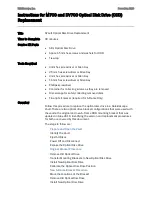
Chapter 7: Technology Background
233
If you set the write cache policy to Write Back, your data is first written to the
controller cache, and later to the physical drive. This action improves
performance. To preserve the data in the cache in the event of a power failure,
the subsystem has a backup battery that powers the cache until service is
restored.
Normally, if the cache backup battery is not present or the battery is being
reconditioned, your logical drive write cache policy is automatically set to Write
Through, so no data is stored in the controller cache. This action slightly reduces
performance but avoids data loss in the event of a power failure. When a battery
is installed or finishes reconditioning, the write cache policy is automatically reset
to Write Back.
The Adaptive Writeback Cache option enables you to set your logical drive write
cache policy to Write Back, even if no cache backup battery is present or the
battery is being reconditioned. This action improves performance but also risks a
loss of data in the event of a power failure.
To enable the Adaptive Writeback Cache option, click the Controller Settings tab.
See “Making Controller Settings” on page 93 (WebPAM PROe) or page 138
(CLU).
Also see “Replacing a Cache Battery” on page 211.
Capacity Coercion
This feature is designed for fault-tolerant logical drives (RAID 1, 1E, 5, 10, 50,
and 60). It is generally recommended to use physical drives of the same size in
your disk arrays. When this is not possible, physical drives of different sizes will
work but the system must adjust for the size differences by reducing or coercing
the capacity of the larger drives to match the smaller ones. With VTrak, you can
choose to enable Capacity Coercion and any one of four methods.
Enable Capacity Coercion and select the Method in the Controller Settings menu.
See page 93 or page 138. The choices are:
•
GB Truncate – (Default) Reduces the useful capacity to the nearest
1,000,000,000 byte boundary.
•
10GB Truncate – Reduces the useful capacity to the nearest 10,000,000,000
byte boundary.
•
Group Rounding – Uses an algorithm to determine how much to truncate.
Results in the maximum amount of usable drive capacity.
•
Table Rounding – Applies a predefined table to determine how much to
truncate.
Capacity Coercion also affects a replacement drive used in a disk array.
Normally, when an physical drive fails, the replacement drive must be the same
Summary of Contents for VTRAK M210i
Page 1: ...VTRAK M610i M310i M210i Product Manual Version 0 9 ...
Page 14: ...VTrak M610i M310i M210i Product Manual xiv ...
Page 22: ...VTrak M610i M310i M210i Product Manual 8 ...
Page 53: ...Chapter 4 Management with WebPAM PROe 39 Figure 1 The WebPAM PROe log in screen ...
Page 144: ...VTrak M610i M310i M210i Product Manual 130 ...
Page 212: ...VTrak M610i M310i M210i Product Manual 198 ...
Page 232: ...VTrak M610i M310i M210i Product Manual 218 ...
Page 256: ...VTrak M610i M310i M210i Product Manual 242 ...
















































